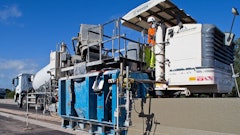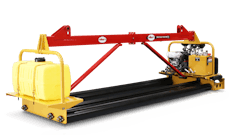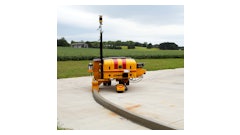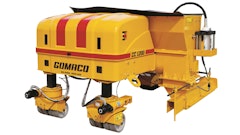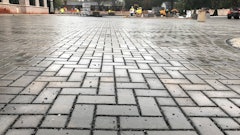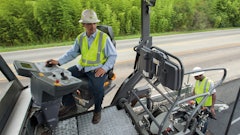For some jobs, it can be readily apparent which concrete paver you should use to achieve the performance and productivity needed. For example, you would typically use a utility paver for parking lots and single-lane roads, but you will want to upsize to a mid-size model for dual lanes. And for interstate highways, you will want a large size paver, probably one with features such as dowel bar inserters.
"The project will help dictate the size of the paver," says Kent Godbersen, GOMACO Corp. "Certain pavers are built for certain project specifications and factors, such as paving width, depth, number of lanes, single or double paving passes, rideability requirements, etc. Project type is also a factor, such as whether it's an airport runway, highway, city street, single-lane addition, interstate or parking lot. Also consider width, which may or may not include tight clearances, rideability specifications and more."
In addition, options such as two or four tracks, bar insertion systems, digital controllers, stringless technology, etc., allow customization to meet specific project needs.
But there can be times when it's more difficult to determine at what point to step up in size or replace existing equipment because it is unable to deliver the needed results.
Stimulus money intended to encourage construction growth can also require that contractors upsize their pavers in order to meet quality standards of tighter job specifications, says Dewayne Allen, Allen Engineering. "That's because they may be moving from a medium- to a high-spec job," he explains. "For example, a subdivision typically doesn't have as high of specs as a road where smoothness is critical."
Consider weight and horsepower
Weight and horsepower both play roles in how well a concrete paver will meet jobsite specifications, so you will have to determine if you have enough of each to meet those specs.
Signs that you're falling short in either or both areas will be visible in your inability to maintain grade control, which can affect the smoothness of the road. Finish can also be negatively affected if you don't have enough horsepower to adequately fluidize the concrete. Plus, you may be left with "bug holes" or surface voids in the concrete that are the result of poor consolidation caused by inadequate weight and vibration.
Concrete pushes up on a paver, similar to what happens when a log floats in water, explains Hershel Cunningham, Terex Roadbuilding. "There's about 2.5 psi on concrete," he says. "If you have a 60-in. pan that's 12 or 14 ft. wide, there is a lot of pressure pushing up on the paver. You will need enough weight to hold it down. If you don't have enough, you will have to slow down, or you may not be able to pave as wide of a surface. The heavier the paver, the faster travel can be and the deeper and wider the concrete can be."
Horsepower is a factor because it not only powers the paver, but also any ancillary equipment, such as plows/augers for spreading concrete; tamper bars for tamping aggregates; and vibrators for making the concrete more fluid to allow for a smoother finish.
"We use manic internal hydraulic vibrators that use around 4 hp each," Cunningham indicates. "We suggest placing them every 12 to 18 in. apart. If you don't have enough horsepower to space them at those intervals, you may not be able to pave as wide as you would like. Usually, if you have enough weight and horsepower, you can work your way through any project."
Take advantage of new technology
Meeting productivity goals also factors into whether or not you choose to upsize a machine. But determining the true productivity of a paver can be difficult.
Productivity is measured in the number of linear feet or cubic yards finished per day. In general, targets such as 3,000 to 4,000 linear feet in an open area like a subdivision are usually achievable goals. Whereas, 1,000 ft. might be more realistic in a parking lot broken up with obstacles such as islands and 90° radiuses that require more time-consuming hand work.
"But high-volume or low-volume production can be very misleading," says Godbersen. "True machine productivity should be measured by bottom line productivity." Productivity can be dependent on several aspects, including the age of the machine.
Of course, the point at which you decide to upsize a machine isn't always a matter of production declining, says Godbersen. "Upsizing can be more about new technology that offers better performance," he notes. "Contractors are always pushing us and coming to us for answers to their latest challenges. It's new and exciting technology for them and us - new bar insertion systems, a new concept paving mold, powerful control systems, variable-width paving, stringless paving applications and more."
Stephen Bullock, Power Curbers, agrees. "Equipment enhancements can be the impetus for contractors to upgrade," he states. "For example, we have made moves that allow you to change molds on our curb and gutter machines quickly, cutting downtime from 45 to 10 minutes. Moving from a belt conveyor to an auger conveyor offers time and quality benefits, including better and faster mixing of the concrete and less maintenance to the machine. We have also moved to hydraulics that provide more jobsite flexibility in how you set up the machine."
Influence of concrete delivery
Factors other than the machine itself can also contribute to how much you can finish in a day, says Allen. "If you are large enough to have your own plant, you can control the volume," he says. "Normally, a modern paver can handle 600 to 700 yds. per hour. But if you're relying on someone else to deliver product, getting 100 yds. can be hard to do. It varies so much."
"A lot depends on concrete delivery and transportation, i.e., how well ancillary support systems work together," adds Cunningham. "If you have a plant that produces 400 yds. per hour, but paving equipment that only allows you to use 100 yds. of that, your paver is undersized for what production could be."
As you grow your business you may also find your paver can't do everything you want it to do.
"Contractors sometimes enter the market spending as little investment as possible," says Bullock. "As they begin to do larger profiles, they may find they don't have enough machine. They can't get jobs done efficiently, or they can't do them at all because they don't have enough weight or horsepower. It's usually demand for work and new opportunities that motivate contractors to upsize their machines."
KEEP PAVERS CLEANED AND SERVICED
Productivity of the existing pavers in your fleet can be linked to how well each machine is cleaned and maintained. It's important to clean pavers thoroughly by washing them after each pour. For preventive maintenance, follow manufacturer recommendations to identify what tasks need to be performed as the paver accumulates production hours.
Downtime with concrete paving equipment can be extremely expensive, says Stephen Bullock, Power Curbers. "But it's not so much the cost of the replacement parts," he observes. "Rather, it's the lost revenue and lost productivity from a machine being down. You typically have a sidelined crew of six to seven people, plus the loss of the concrete itself. A sidelined machine can quickly add up to a large loss."
"Concrete is an extremely unforgivable product," adds GOMACO's Kent Godbersen. "Large amounts of money are at risk on each day's pour. The contractor needs to have a reliable paver in excellent operating condition, which is ready to handle the rigors of the paving season. If the contractor takes care of his machine, follows the recommended schedule of maintenance and properly cleans the paver after each pour, the machine is going to last a long time."









